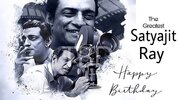Mr. Mysterious
Newbie
মহারাজা তোমাকে সেলাম
102তমো জন্মদিন ওনার।উনি না থাকলে আমরা শৈশব আর কৈশোর হারাতাম।। প্রফেসর শঙ্কু ,ফেলুদা, থেকে আরো অনেক গল্প উপহার দিয়েছেন।।তার জন্ম দ্বিশতবর্ষে তাকে জানাই শতকোটি প্রণাম আর জন্ম দিনের শুভেচ্ছা


The day Satyajit Ray was born, the definition of cinema was rewritten in the history of Indian cinema. He is that man whose magic behind the camera has never failed to mesmerize our eyes with every shot, every light, every action and every film.
Satyajit Ray's films are those films, which touch our hearts and stay with us forever. Time has not been able to bring any difference in its appeal. His books, his characters, his sketches and Ray as a man has touched the hearts of not only Bengali's but people universally.
2nd May, on his birth anniversary, let us all celebrate the birth of this legend, Satyajit Ray by taking a tour in his magical world.
View attachment 129081

